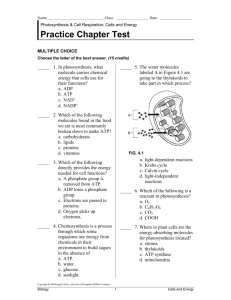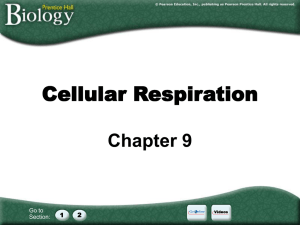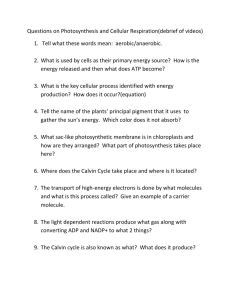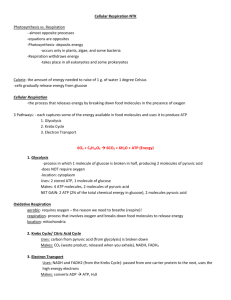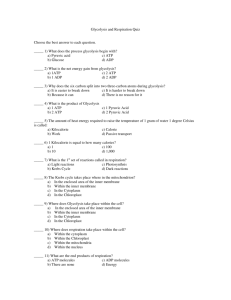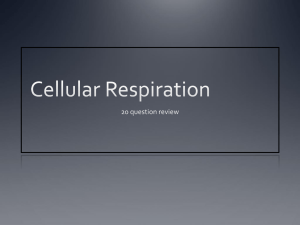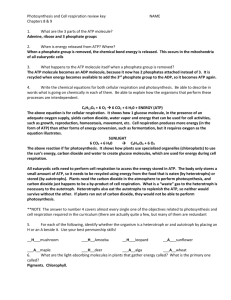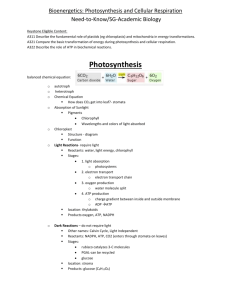Photosynthesis & Cellular Respiration
advertisement
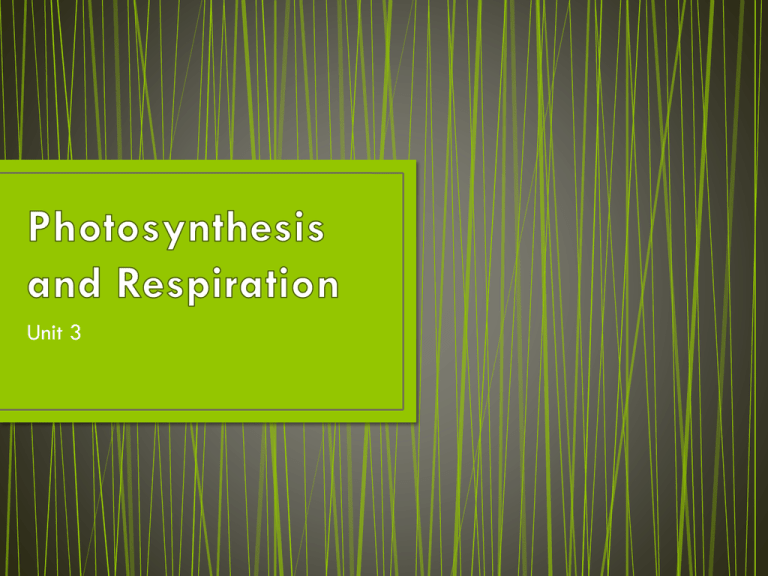
Unit 3 • Living things use energy for •Growth •Repair •Reproduction •Metabolism • The collection of reactions that occur in a cell • Involves either: • Using energy to build molecules (condensation reactions) or • Breaking down molecules to release the stored energy (hydrolysis) • Photosynthesis is the process by which light energy is converted to chemical energy • Organisms that use energy from sunlight (or from chemical bonds in inorganic substances) to make organic compounds are called autotrophs • Organisms that must get energy from food instead of directly from sunlight (or inorganic substances) are called heterotrophs • Heterotrophs get energy from food through the chemical process of cellular respiration, remember that autotrophs perform cellular respiration also! • Photosynthesis changes the energy of sunlight into the chemical energy stored in glucose bonds • Photosynthesis is the connection between the sun and the energy needs of living systems • 6CO2 + 6H2O C6H12O6 + 6O2 carbon dioxide + water glucose + oxygen • In addition to water and carbon dioxide, photosynthesis requires light and chlorophyll • The chlorophyll inside the chloroplast of leaves absorb light • Chlorophyll does not absorb all the wavelengths of visible light equally • Chloroplast – organelle in plants where photosynthesis takes place • Thylakoids – Saclike photosynthetic membranes • Grana- Stacks of thylakoids • Stroma- aqueous region outside the grana • Breaks apart H2O to produce oxygen gas • Convert ADP and NADH+ into ATP and NADPH • Takes place within the thylakoid membranes in the chloroplast • Uses ATP and NADPH from the light dependent reactions • Produces high-energy sugars • Takes place in the stroma of the chloroplasts • Does not require light • Water • Temperature • Depends on enzymes that function best between 0oC and 35oC • Intensity of light • Increasing light intensity increases the rate of photosynthesis to a point • Carbon Dioxide Concentration • Nutrients • Glycolysis does not require oxygen. • Aerobic respiration: oxygen is present, glycolysis is followed by the Krebs cycle and then the electron transport chain. • Anaerobic respiration: no oxygen, glycolysis is followed by fermentation • 3 Stages of Aerobic Cellular Respiration: 1. Glycolysis 2. the Krebs cycle 3. the electron transport chain • Each of the 3 stages of cellular respiration uses energy from food to produce ATP • Respiration begins with a pathway called Glycolysis. •Glycolysis releases a small amount of energy. •Uses 2 ATP to make 4 ATP and 2 pyruvic acids • The “power house” of the cell, because most of the ATP is produced here. • Oxygen is required • During the Krebs cycle, pyruvic acid is broken down into: • CO2 • NADH • FADH2 • ATP: The Krebs Cycle makes 2 ATP • Each pair of high-energy electrons moves down the electron transport chain (ETC) and provides the energy to produce more ATP. The break down of glucose by aerobic cellular respiration results in the production of 36 molecules of ATP. • When oxygen is not present, glycolysis is followed by a different pathway. 2 types of fermentation: anaerobic (no oxygen) Lactic Acid Fermentation Alcoholic Fermentation • No ATP are produced • Lactic Acid Fermentation • Pyruvic acid lactic acid (lactate) • Alcoholic Fermentation • Pyruvic acid ethanol & CO2 • DURING ANAEROBIC RESPIRATION ONLY 2 ATP ARE MADE • A high energy molecule that stores energy needed by cells • Made in the mitochondria • Composed of: • Ribose (5 carbon Sugar) • Adenine (nitrogenous base) • 3 phosphate groups (group of molecules made up of phosphorous and oxygen) • The removal of 1 phosphate group from ATP produces ADP (Adenosine DiPhosphate) • This reaction releases energy in a way that enables cells to use the energy • Plants also contain the organelle, mitochondria, which converts the high energy carbohydrates made by the plant through photosynthesis in the chloroplast into ATP for the plant to use to perform cellular functions.

